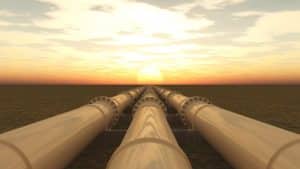Public Service Commission Approves Bridger Pipeline
 The Public Service Commission (PSC) recently authorized a $21 million pipeline conversion project that will take North Dakota oil to a hub in Wyoming. According to the PSC application, Bridger Pipeline will convert an already existing 27-mile gathering line in McKenzie County and build another 2.4 miles of eight-inch pipeline.
The Public Service Commission (PSC) recently authorized a $21 million pipeline conversion project that will take North Dakota oil to a hub in Wyoming. According to the PSC application, Bridger Pipeline will convert an already existing 27-mile gathering line in McKenzie County and build another 2.4 miles of eight-inch pipeline.
The new transmission line will start at Bridger Pipeline’s Johnson’s Corner terminal and terminate at its Wilson Station location in Watford City. From Watford City, the oil will travel to the Wyoming location – where it can connect with refineries and markets in Colorado and Utah – and with trading centers in Oklahoma and Patoka, Illinois. According to the Williston Herald, Bridger’s line is expected to transport between 25,000 and 50,000 barrels each day or production.
Justin Kringstad of the North Dakota Pipeline Authority informed the Williston Herald that “Currently there is available incremental pipeline capacity from Baker, Montana going south. However, today’s limiting factor is pipeline capacity to move barrels to Baker.” From Baker, oil can be transported to hubs in Oklahoma or Wyoming where the oil can then be transported to Gulf Coast or other refineries. Kringstad said that any increase in capacity will “greatly assist in moving North Dakota oil in the future, particularly with the uncertainty surrounding DAPL.”
Bridger Pipeline and another company, Seahorse Pipeline (a Tallgrass subsidiary) “announced an open season for Bakken crude transport from the Bakken and Wyoming to Texas and Midcontinent destinations in March” which will start on June 1, 2021.
Are there concerns about the proposed Bridger Pipeline?
Given the ups and downs surrounding the DAPL over the past few years, it’s good news for North Dakota that another pipeline plan is in place. Still, the Williston Herald noted a few concerns about the new line proposed by Bridger:
- The land is shaky. The proposed line will take the oil through an area that has experienced several landslides in the past. Just this past March, Bridger was required to answer many questions about the proposed project, due to the line’s location and Bridger’s prior spill history.
- Bridger has a history of spills. Bridger was fined $1 million for a crude oil spill in 2015. The oil spilled into the Yellowstone River, “after a weld split open and put the Glendive water supply at risk.” The new pipeline will cross five named creeks.
In considering the Bridger proposal, Julie Fedorchak, the Public Service Commissioner, said that the PSC spent a good amount of time considering that the line “goes through some rugged terrain, as do several of their other pipelines, and they have experienced some sloughing that caused some damage to previous pipelines.” She added that Bridger Pipeline “has focused in on their efforts in these potentially geologically unstable areas, and it seems to have a pretty ongoing monitoring system in place for mitigating any future concerns in those with that type of geology.”
Ms. Fedorchak said that the new line will have electronic monitoring, with a “line-balancing system that tracks pressure and density,” and a supervisory control and data acquisition system that trained personnel will monitor around the clock.
She added that the PSC conducted a full review of the converted portion of the pipeline and the new construction. Ms. Fedorchak emphasized that the project is “another nice piece of transportation, external of the state transportation network, the pipeline transportation network, for crude oil produced in the Bakken.”
Ms. Fedorchak emphasized that a pipeline is the choice way for transporting crude oil to travel. Pipelines are the best way of transporting oil because they have the least environmental impact. The pipeline is a strong investment in North Dakota’s pipeline infrastructure. She added, “it’s really important to permit and monitor these pipeline operations and ensure they are safely constructed and operated for the duration.”
Why pipeline work is so dangerous
Pipeline companies need to be concerned about their workers in addition to the danger of oil spills and accidents. Oil field and oil transportation workers are at constant risk of death and injuries. Pipeline workers are also at risk of toxic spills and other accidents. Breathing in these toxic fumes can damage your lungs. Spills on a worker’s body can cause rashes, infections, chemical burns, and skin damage. Long-term exposure to toxic chemicals can affect a worker’s respiratory and neurological systems.
We’re thrilled that our oil and gas workers will have new projects to work on – as long as Bridger is safe about it. We have represented enough pipeline workers to know the dangers.
At Larson Law we provide aggressive counsel to oil and gas injury victims in Minot, Bismarck, and throughout North Dakota. We handle wrongful death, personal injury, and other oilfield accident claims. Contact us today at 701-484-HURT, or complete the contact form to schedule a consultation. Initial consultations are free.

Mark Larson is a Certified Civil Trial Specialist and Certified Civil Pre-Trial Specialist focusing on personal injury, car accidents, wrongful death, and oil field claims. Since 1979, Larson Law has served the injured throughout North Dakota. Read more about Mark V. Larson.
